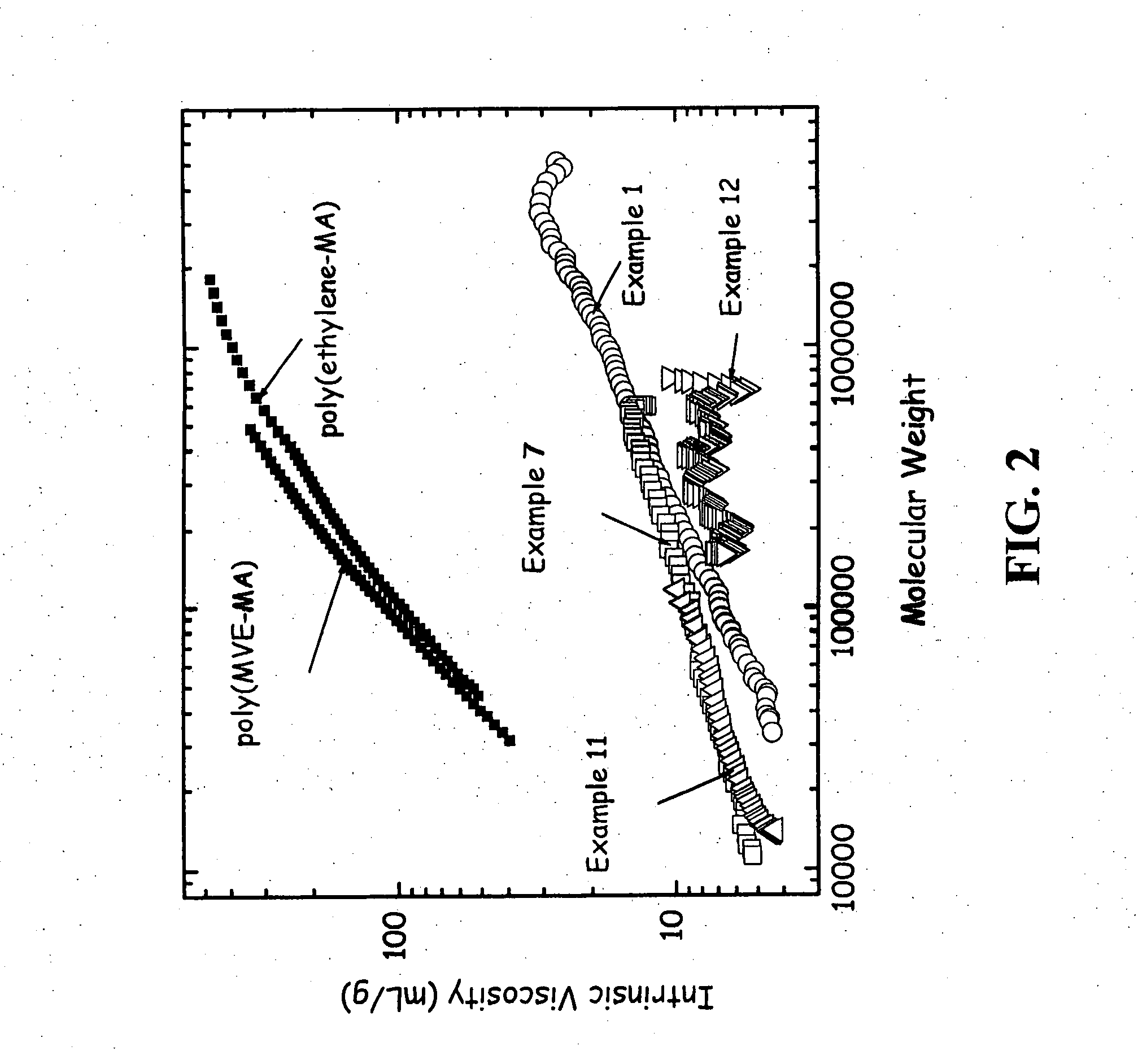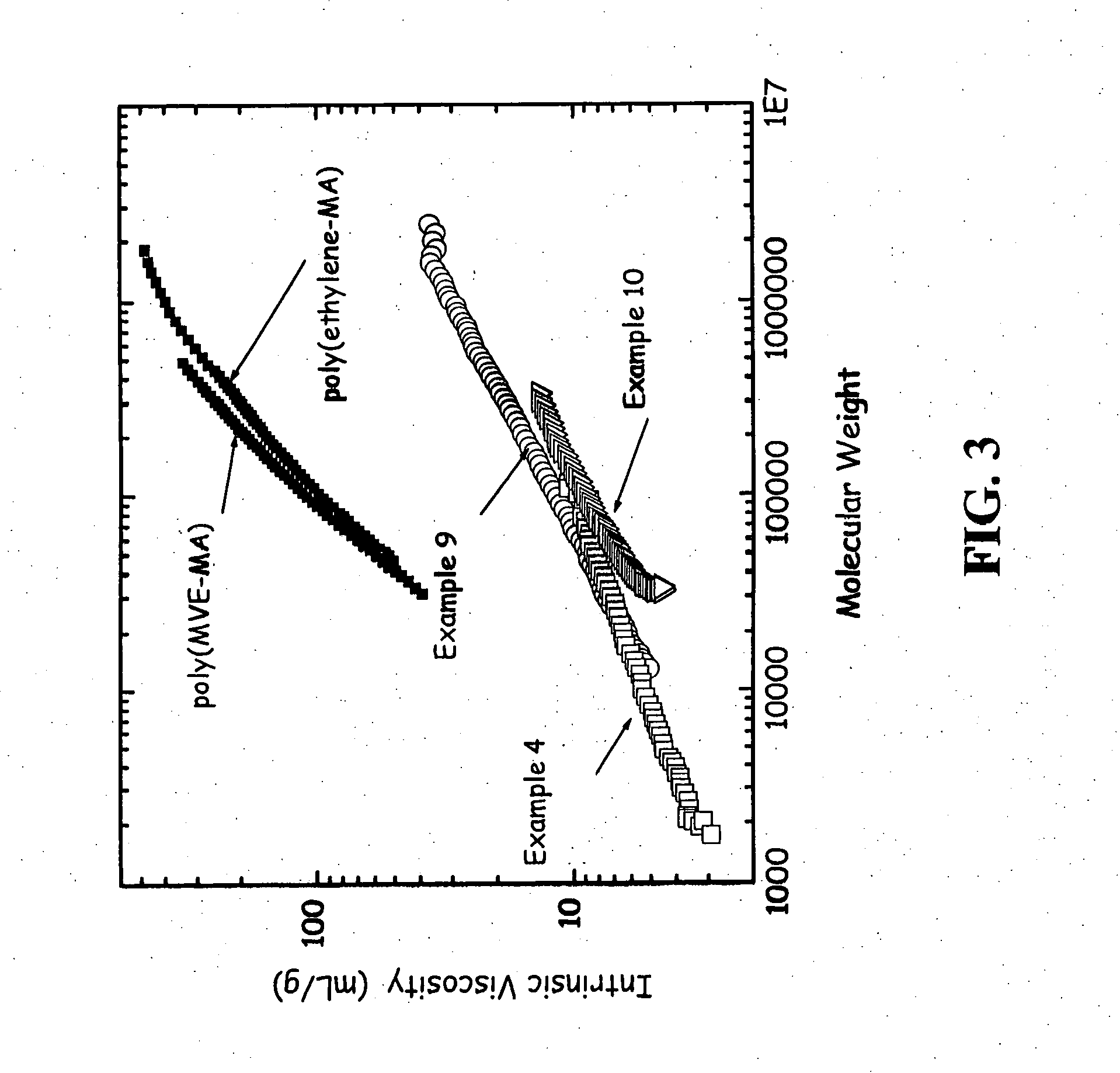Hyperbranched maleic anhydride-diene polymers
- Summary
- Abstract
- Description
- Claims
- Application Information
AI Technical Summary
Benefits of technology
Problems solved by technology
Method used
Image
Examples
example 1
[0091] This Example shows the polymerization of 1,7-octadiene with maleic anhydride. 1,7-octadiene (88.0 g, 0.80 mol), maleic anhydride (78.4 g, 0.80 mol), and acetone (800 g) were added to a 2 liter round bottom flask with overhead stirring, a condenser with a 0° C. refrigerant, a thermocouple temperature measurement, a nitrogen purge, a solid dropping funnel, and a heating mantle. The solution was stirred at room temperature until all the solids had dissolved. The solution was then heated to 50° C. and the solution was purged subsurface with nitrogen for one hour. Benzoyl peroxide (29.2 g, 0.12 mol) was then added as a solid over a 0.5 hour time period. The solution was held at 50° C. for 48 hours. The reaction was monitored with gas chromatography by following the disappearance of the 1,7-octadiene and maleic anhydride monomers. At the end of the reaction about 50% of the 1,7-octadiene remained while the maleic anhydride was consumed. The solution was then allowed to cool to room...
examples 2-3
[0095] The following Examples were performed under the same conditions as Example 1 except they were performed at 0.25 the scale of Example 1 and the amount of initiator was varied. These Examples are based on 22.0 g (0.20 mol) of 1,7-octadiene, 19.6 g (0.20 mol) of maleic anhydride, and 200 g acetone in a 500 ml round bottomed flask. These Examples demonstrate that the yield decreases with decreasing amount of benzoyl peroxide relative to the monomers. That is, for Examples 2 and 3, using same relative amounts of diene and maleic anhydride, polymer yield was much higher with a higher loading of benzoyl peroxide initiator. Results are summarized in Table 1.
TABLE 1Initiator Amount vs. YieldExampleBenzoyl Peroxide (g, mol)Isolated Yield (g)22.4 g, 0.01 mol13.130.80 g, 0.003 mol6.0
example 4
[0096] This Example shows the effect of a lower diene to maleic anhydride molar ratio. 1,7-octadiene (11.0 g, 0.10 mol), maleic anhydride (19.6 g, 0.20 mol), and acetone (200 g) was added to the same reactor as in Examples 2-3 and done under identical conditions. The reaction was heated to 50° C. and the acetone solution was purged subsurface with nitrogen for one hour. Benzoyl peroxide (7.3 g, 0.03 mol) was then added to the solution over a 30 minute time period. The reaction was heated for 20 hours at 50° C. The yield of desired copolymer product was 11.2 g. The 1H NMR results were 8 mole % phenyl from initiator, 19% vinyl and 14% saturated 1,7-octadiene. The 13C NMR showed maleic anhydride (63 mole %), unsaturated olefins of 1,7-octadiene (18 mole %), saturated branching of octyl (12 mole %), and initiator fragments (7 mole %). Further characterization is presented in Table 2 and in FIG. 3 and discussed below.
[0097] This Example demonstrates that the yield decreases with lower d...
PUM
| Property | Measurement | Unit |
|---|---|---|
| Percent by mass | aaaaa | aaaaa |
| Percent by mass | aaaaa | aaaaa |
| Reaction temperature | aaaaa | aaaaa |
Abstract
Description
Claims
Application Information
 Login to View More
Login to View More - R&D
- Intellectual Property
- Life Sciences
- Materials
- Tech Scout
- Unparalleled Data Quality
- Higher Quality Content
- 60% Fewer Hallucinations
Browse by: Latest US Patents, China's latest patents, Technical Efficacy Thesaurus, Application Domain, Technology Topic, Popular Technical Reports.
© 2025 PatSnap. All rights reserved.Legal|Privacy policy|Modern Slavery Act Transparency Statement|Sitemap|About US| Contact US: help@patsnap.com



